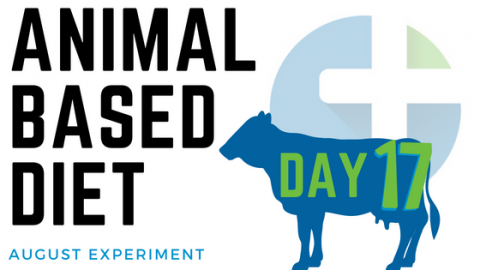
I was waiting for today as on the schedule for my workout was a 2,000 meter row, 1 mile run, 2,000 meter row, 1 mile run, 2,000 meter row. A version of this was performed about 2 weeks ago when I started eating an animal based diet, except it was shorter with only 2 of the rows and 1 of the runs. I totally bonked that first time around only completing the first 2,000 meter row, rolling off the rower, with nothing left in the tank.
Due to the class size I did the assault bike instead of row and my equivalent 2,000 meter row time translated to a 4,300 meter assault bike. And. It. Felt. Great. I felt strong on the runs, I kept my pace the whole time on the bike and while I was winded at the end, it wasn’t because I bonked. I didn’t break any records but I was pleased with the result. Within 2 weeks I went from tanking on an 8 minute row to feeling strong through a 40 minute cardio battle.
I guess I can say I’m ‘meat adapted.’
Over the Past Week I Have Averaged:
238 grams of protein/day
143 grams of fat/day
59 grams of saturated fat/day
688 mg of cholesterol/day
What will this mean for my lipid markers? I fully expect them to rise. Will this scare me that I’m increasing my cardiac risks? Not at all as long as inflammatory and insulin markers remain low. You’ve been told there is good and bad cholesterol. You’ve been lied to repeatedly for the sake of selling a drug. LDL is vital. HDL is vital. Neither is good. Neither is bad. They are vital.
If you’ve read any of my stuff before, you know this isn’t a new concept I’m harping on. But it is nice to hear it from cardiologists. I just listened to a great interview with Dr. Nadir Ali going into much more depth concerning the vital roles LDL plays in functions from immune system, hormones, and cell repair. As a native of India, an interesting point he makes is that India has the lowest consumption of meat per capita in the world but the fastest growing epidemic of diabetes per capita in the world. He also makes a point that Hong Kong has the highest life expectancy with the highest meat consumption per capita whereas India’s life expectancy is almost 20 years less.
With life expectancy, we have to remember that it’s an average of ages. There could be many people living into their 90s but if they also have lots of babies dying due to sanitation and nutrition issues, this can bring the life expectancy way down. You can have 1 person live till 80 and a toddler die at age 2, so therefore the life expectancy is only 41. The reality for most countries is that life expectancy drastically increases after you hit age mile stones like 1 year, 2 years, 5 year, etc. Therefore I won’t be hash tagging ‘meat eaters live longer’ quite yet.
But with 86% of American healthcare expenditures going towards chronic illness, and diabetes and obesity sky rocketing in our nation, could a meat based diet put a dent in those stats? But would it be the meat eating or the avoiding of grains, especially with the massive insulin impact of grains and all the levels of glyphosate (Monsanto’s GMO-friendly pesticide) that would be avoided?
This experiment is creating more questions than answers. One question is, should I do another 30 days when this is over?


0 Comments